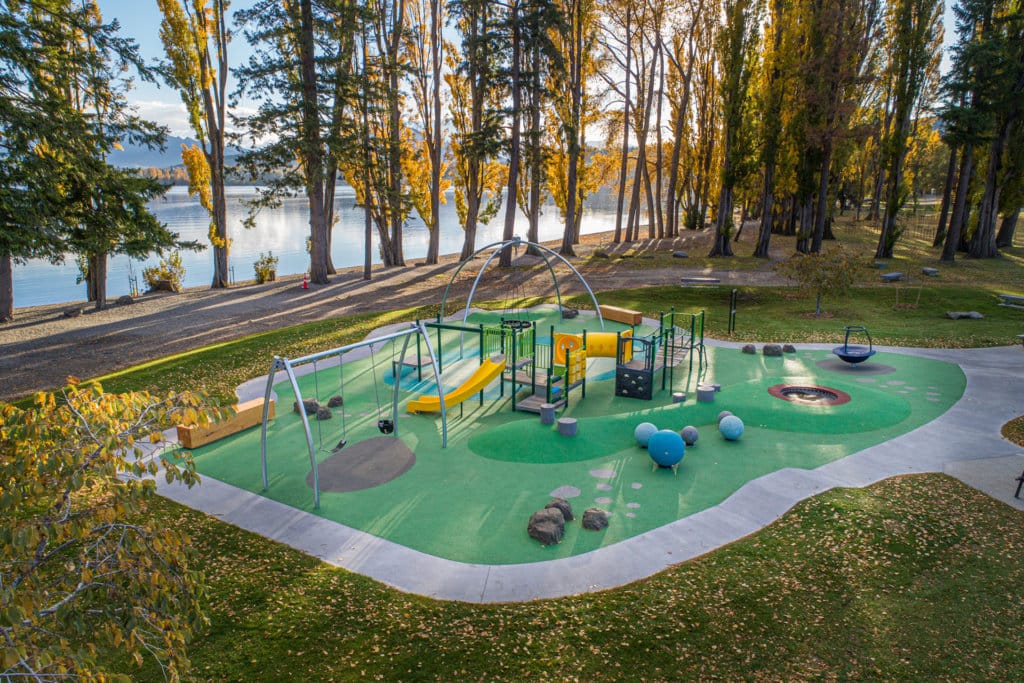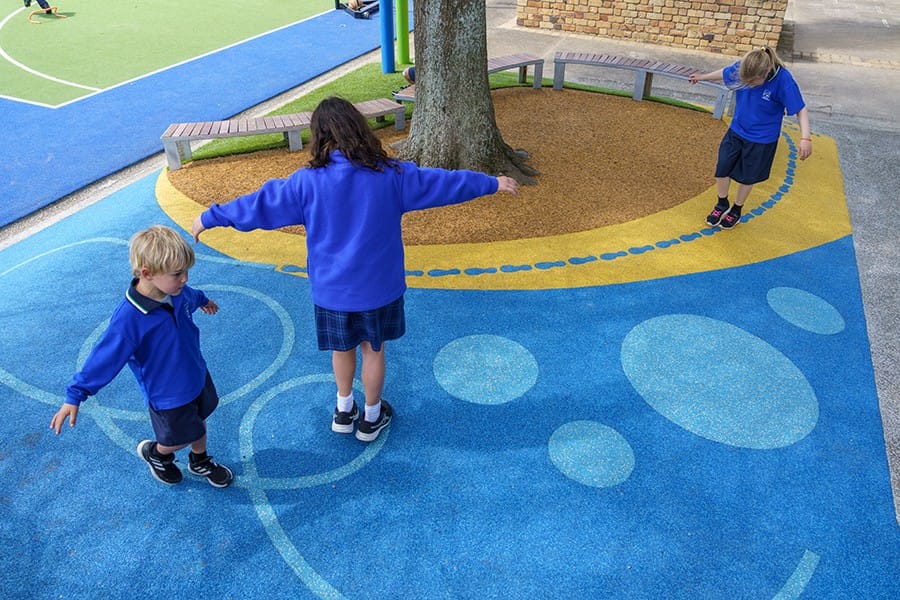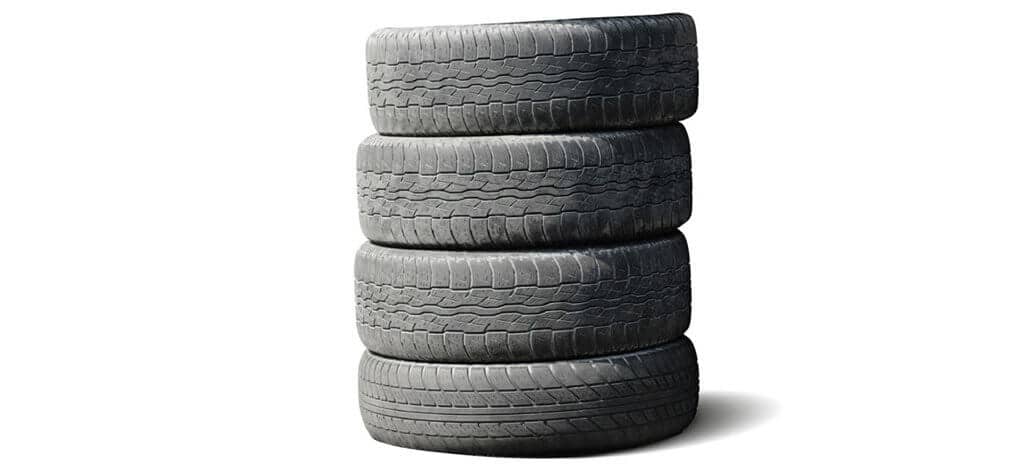10 reasons to choose synthetic playground surfacing

If you’re considering replacing or installing a new playground surface, you’ll no doubt be thinking about whether to go with a natural surface or a synthetic one.
In our experience, the answer to this question comes down to the context in which it is being asked.
For example – those with larger budgets may choose to have a mix of both synthetic and natural surfacing to gain the benefits provided by each. But often, budget constraints restrict people from choosing just one option.
In this article, I want to make the case for why choosing synthetic playground surfacing over natural is the better choice when you can’t have both. But before I list my reasons, I think it’s worth defining what I mean by synthetic and natural surfacing.
By ‘natural’ play surfacing, I mean any natural material that is recognised and accepted as a play safety surface in the New Zealand playground equipment and surfacing standards (NZS 5828:2015). These are bark, woodchip, gravel, and sand.
When I talk about ‘synthetic’ play surfaces, I’m talking about cushioned synthetic turf, wet pour rubber, and the various playground tile products that are also recognised in the New Zealand playground standard.
With that aside – here are my top 10 reasons for choosing synthetic play surfacing:
Click Here to Compare Other Playground Surface Options in our Product Catalogue
1. Synthetic surfaces last longer
It’s a little-known fact that the average natural, loose-fill playground surface requires ‘topping up’ once every year and replacement every 3-5 years. The reason for this is that loose-fill surfaces degrade quickly over time through compaction, erosion, weathering and general wear and tear.
As you’ve probably seen in your own garden, loose materials like bark chips tend to not stay where they are put. In the playground situation, it doesn’t take long for these types of materials to spill out from their intended locations creating a mess for someone to clean up, a choking hazard for small children, and a risk to people who may trip or slip on the loose material.
Synthetic surfacing, on the other hand, doesn’t move, disintegrate, or require ‘topping up’. It’s not uncommon for a high-quality synthetic surface to last for 15 or even 20 years. You can see why people often say that synthetic surfacing is the true ‘set and forget option.

2. Appearance
Okay, this one is a little subjective – they do say that beauty is in the eye of the beholder after all. But, when you consider the range of colours and textures that can be achieved with synthetic surfacing, you see how the natural options come up looking just a little… well, dull.
Also, when you consider that natural surfacing deteriorates quickly under lots of little feet, you understand why overwhelmingly, children and families prefer parks with synthetic surfacing; there’s just far less mud and dirt to deal with when the play is done.
Furthermore, synthetic options like artificial turf have the appearance of natural grass, but none of its drawbacks, such as the tendency to turn into mud when it gets wet and the necessary mowing and maintenance in spring and summertime.
In this light, synthetic surfacing, by far, looks like the better option.

3. More Colour
I’ve already mentioned colour as an advantage over natural surfaces, but it’s worth repeating. Synthetic surfaces give you a range and depth of colours that is totally unrivalled by natural surfacing products. To give you an example, our Pour’n’Play wet-pour rubber surfacing comes in 22 colours that can be mixed and blended to create unlimited variations of colour.
This means you can create any world you like with your playground! We’ve seen people create mountains, fields, rivers, oceans, beaches, moonscapes, and even volcanoes with synthetic play surfacing!
I think I’ll end this point with a few photos of some of the amazingly colourful playgrounds we’ve worked on over the last few years. I think you’ll agree – these pictures speak a thousand words.
Click Here to Compare Other Playground Surface Options in our Product Catalogue




4. Safety
We install playground surfacing for one major reason – safety. If kids were bulletproof, playgrounds wouldn’t need it.
While most natural playground surfacing options are safe at the time of installation, there are factors that can cause them to become unsafe – far sooner than synthetic surfaces.
The reason for this is that natural loose-fill safety surfaces move around with play. It doesn’t take long before dips and hollows form in the surface, particularly around the equipment where a minimum level of material is needed most. Essentially, these areas go from safe to unsafe in a very short timeframe.
Synthetic surfacing, by contrast, doesn’t move and remains consistent, providing the appropriate level of critical fall height safety for the equipment in use.
Due to the consistency of synthetic surfaces, they are more amenable to being engineered to provide long-term safety benefits and are hence, safer than the alternative loose-fill surface options.
The Numat Pour’n’Play System
Critical Fall Height (CFH) Specification

Click Here to Compare Other Playground Surface Options in our Product Catalogue
5. Maintenance
I’ve already discussed how synthetic surfaces are much tidier than loose-fill ones, but it’s worth considering just what this means in terms of maintenance.
Anyone who has managed a playground knows how important maintenance is in ensuring the thing looks good and is safe for use in the long term. Anyone who has maintained a loose-fill playground surface will attest to how much of an uphill battle it is; the futile task of trying to control bark chip and pebbles that just want to spread out as far and wide as possible.
Synthetic surfacing, on the other hand, requires very little in the way of maintenance. Synthetic turf and rubber surfaces can be reasonably well maintained with just a single groom, once every 1 – 2 years, depending on use.
Contrast this with a bark chip playground surface that requires constant weekly sweeping or blowing to put back the loose material and you can see how installing a synthetic surface will save you thousands of dollars and hundreds of hours each year.
This alone is a good case for choosing synthetic surfacing over natural.

6. Sustainability
When you think of synthetic surfacing, you don’t immediately think of environmental sustainability – but you should!
It’s not well known, but many synthetic surfacing products (including some of ours) come from recycled material that would otherwise be burned or put into landfill.
Our Pour’n’Play surface uses recycled rubber from scrap tyres in its shock pad and top layer. The number of scrap tyres in a square metre of this surface ranges from 2.3 to 8.9 tyres depending on the amount of black rubber used in the top layer and the required depth of shock pad underneath.
On average, Pour’n’Play uses around 4 tyres per square metre – which equates to around 63kg of CO2 emissions that won’t be released into the atmosphere through incineration.
Also, at the end of its life, Pour’n’Play can be recycled into other products, such as horse arena surfacing.
So, as you are weighing up your surfacing options and thinking to yourself, “should I go with the natural ‘good for the environment’ option?” Stop and think! You could be doing the environment a far greater service by choosing a synthetic surface.

7. Play Value (FUN!)
It’s no secret – kids love physical play! Whether it’s bouncing, running, jumping, climbing or tumbling, kids are most happy when they are moving.
I’d like to make a bold claim. Here it is… movement is easier and more FUN on synthetic play surfaces. What scientific evidence do I have for this claim? Well… none, actually. But, if you watch and compare how children play on natural vs synthetic surfaces, you’ll see how the synthetic playground surfaces provide much more value in terms of grip, texture, cushioning and bounce!
Try it yourself. Next time you take your kids to a playground that has a synthetic surface, have a run and a jump and compare that to what it’s like to play on the natural, loose-fill surfacing. I’m confident you’ll feel the play value you get from synthetic surfacing.
Click Here to Compare Other Playground Surface Options in our Product Catalogue

8. Creativity
When you think about playground surfacing, you don’t automatically think about creativity – but I’d like to suggest you do. Here’s why…
The fact is, there are things you just can’t do with natural surfaces. For example, climbing mounds are near impossible and patterned design is simply out of the question.
With synthetic surfaces, you have huge scope for creativity – which is why many playground designers and landscape architects love working with them. Here’s a quote from Jasmax Landscape Architect, Adrian Taylor, who used Pour’n’Play in the design of the St. Andrew’s College Stewart Junior Centre Playground in Christchurch:
“The advantage of Pour’n’Play was that you could design something so crisp and so graphic and have it executed so closely as you intended right down to the colour mixes. Being able to mould it over any kind of shape, especially irregular forms. As a designer, having that flexibility is optimum because you can design to your heart’s content knowing that you’ve got a product that can execute it as intended.”

9. Economical
Synthetic playground surfacing is far more expensive than natural surfacing, right?
Well, let me ask you – would you buy a product that needed servicing every year when if you paid a little more upfront you could get a superior product that wouldn’t need replacing for at least 15 years?
Of course not!
Over the 15-years, you’d end up paying much more in servicing costs than you would if you had chosen the quality product. This is the choice before you with playground surfacing. Loose-fill surfacing comes with a significant annual up-keep cost which makes it more expensive than synthetic surfacing after just 9 years.
So, it’s important when weighing the costs of each option, to take a ‘life-span’ view and ensure you are considering the true cost of each option.
Click Here to Compare Other Playground Surface Options in our Product Catalogue
10. Accessibility
This is the last point. And it’s an important one!
Unfortunately, for many kids with disabilities in New Zealand, visiting the local playground is a disappointing experience. A lack of appropriate play equipment is one reason for this. Another is a lack of appropriate play surfacing.
Loose-fill surfacing products are terrible for children with disabilities. Not only do they hinder their access, but they also get wet and muddy, which is a real problem for children who don’t have the mobility to easily get to the higher, dryer parts of the playground.
Synthetic surfacing, by contrast, provides a nice even surface to play on. Not only that, but most synthetic surfaces dry quickly and can be used not long after the rain stops.
We hear from parents of children with disabilities who love our play surfacing and what it means for their children. Here’s a note we received from one such parent who wrote to us after visiting the Greater Green Island playground in Dunedin:
“We usually look for playgrounds where there is at least one thing our daughter can go on, but at this park there are many! She was so happy there this morning. I had underestimated how great this was going to be and only today realised just how thoughtful the grounding was! We usually have to carry our daughter to each piece of equipment but here she can happily crawl, sit (and walk!) on this without getting wet or muddy. Thank you to your team for adding such an INCLUSIVE and fun playground into the community!”

So, there you have it! 10 very compelling reasons to choose synthetic play surfacing. If you’d like to talk to us about any of the products mentioned in this article, please feel free to contact us on 0800 686 124. We’re more than happy to provide advice and help you work out what you need.



